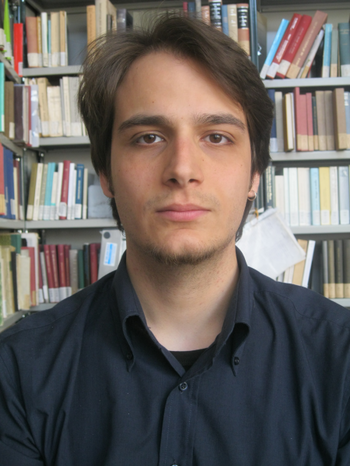Federico Longo M.A.

Ancient Languages and Texts (ALT)
Ancient Near Eastern Studies
Institut für Altorientalistik
Fabeckstraße 23–25
14195 Berlin
Education
Spring 2012
University of Florence, MA degree in History curriculum Ancient Near East;Thesis: "White and Black. Sources and Symbolism of color in the Hittite culture", with vote 110/110 magna cum laude
04 – 09/2011
ERASMUS Scholarship: Semester at the Freie Universität Berlin for researching and collecting bibliography on the Master thesis.
Spring 2008
University of Florence, BA degree in History curriculum Ancient History of the East;Thesis: "A healing ritual for Išḫara", with vote 110/110, magna cum laude
Participation to Archaeological Excavations
08/2010
Participation at the third year of the Survey Project in the archaeological site of Uşaklı Höyük (Turkey), with the Archaeological Mission of the University of Florence, Director Prof. Dr. Stefania Mazzoni (University of Florence)
08 – 09/2009
Participation at the second year of the Survey Project in the archaeological site of Uşaklı Höyük (Turkey), with the Archaeological Mission of the University of Florence; Director Prof. Dr. Stefania Mazzoni (University of Florence)
The Global Ritual Knowledge and the Local Ritual Schools in the Hittite Tradition
The Hittite ritual corpus known from the Hittite archives shows that the presence of compositions ascribed to different traditions originated both inside and outside of Hittite Anatolia. In this textual corpus it is possible to distinguish central Anatolian compositions (characterized by Hittite, Hattian or even Luwian elements), “foreign” rituals perhaps imported from outside of the empire (i.e. Mesopotamia and Syria), and rituals attributable to more or less specific Anatolian “peripheral” areas – dominated by a specific speaking group, that eventually became part of the Hittite kingdom (Arzawa, Kizzuwatna, the Lower Land). The main goal of this project is the study of these regional ritual traditions and the identification of their specific features through the analysis of some of the compositions which have been labelled as “foreign” by both Hittite scribes and modern scholars.
The Hittite ritual compositions show two main interesting features. While, on the one hand all rituals show a common structure – by which the ritual is built and performed – on the other hand these texts qualify themselves as part of a specific tradition, such as Hurrian, Mesopotamian, Kizzuwatnean, Arzawean, or Luwian, thanks to the presence of specific elements. The former feature can be related to their recovery in the excavation of one scribal centre, the city of Ḫattuša, and it can be due to a process of recording that involved a standardization of the material processed by the scribes of the capital. The second feature can be interpreted as a possible trace of the ultimate ‘foreignness’ of at least a part of the transmitted material.
Approach
This project aims to investigate the existence and the nature of the foreign traditions that have left their traces in the Hittite compositions. An important interpretation for this research concerns the similarities that have been observed among different ritual compositions, about some or all the parameter above mentioned. To easily approach the textual material, the Hittite rituals have been grouped on the basis of these similarities. Among these traces of foreign material, two can be considered of particular importance: the use of foreign language, employed to record the whole composition or just the incantations (to be recited while performing the ritual), and the provenience of the author of the ritual, to be found in the incipit and sometimes also in the colophon of the text. Further examples of these ‘foreign traces’ are the mentions of specific ‘local’ or ‘regional’ panthea, cultic functionaries, specific cultic terms, and geographical references.
However, a methodological problem arises, namely how to judge the reliability of each ascription. The information about the provenience of the author allows an easy association of the composition to a – more or less – well identified political and historical entity, as for example Arzawa, Kizzuwatna, Mukiš, or Babylonia. The majority of the documentation, however, does not show this characteristic, and the focal point of the investigation becomes the linguistic criteria, either alone or associated with others elements. This parameter normally does not authorize a clear identification with any known kingdom or region, and requires a further chain of interpretations, making the ascription much more debatable. In order to analyze this fuzzy material, different systems of classification are in use, such as (1) the Kultschicht model, defined in the English literature as “cultural (or cultic) strata or layers” and “cultural milieu”, although the two English definitions do not perfectly match their German counterpart, and (2) the “ritual school” interpretation. While the first one bases essentially on the linguistic criteria, and only secondary combines them with the others, the second takes into account also other elements as categorizing parameters, without necessarily referring to the linguistic one.
Finally, a further consideration is discussed in this project that could also be a consequence of the ‘adaptation process’ operated by the ancient scribe to this variegated material. Parallels between the ritual actions, the deities, the use of foreign words and recitations inside a group of texts may be – in some instances – the result of the same purpose shared by two or more different compositions, rather than just the sharing of a common cultural background, as it has been suggested. More than having a common ritual tradition, they can belong to the same ‘ritual’ genre or typology.
The thesis is being written within the Research Group Space – identity – locality. The construction of knowledge related identity spaces of the Excellence Cluster 264 Topoi.
